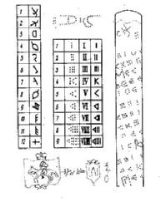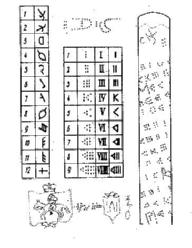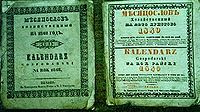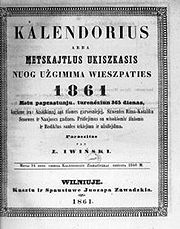
Lithuanian calendar
Encyclopedia
The Lithuanian calendar is unusual among Western countries in that neither the names of the months nor the names of the weekdays are derived from Greek
or Norse mythology
. They were formalized after Lithuania
regained independence
in 1918, based on historic names, and celebrate natural phenomena; three months are named for birds, two for trees, and the remainder for seasonal activities and features. The days of the week are simply ordinal numbers.
 Ancient Baltic cosmological schemes have been found on burial urns dated from 600-200 BC. As with other Bronze Age
Ancient Baltic cosmological schemes have been found on burial urns dated from 600-200 BC. As with other Bronze Age
cultures, there were megaliths associated with the summer and winter solstice
s; hill enclaves with solar calendars have been discovered at Birutė
Mountain near Palanga
, and at the Purmaliai mound near Klaipėda
. A modern interpretation of the ancient solar calendar was created in 2002 at the Kretinga Museum
.
The Gediminas Sceptre, discovered in 1680, indicates that during his reign the year started in April and was divided into 12 months, varying in length from 29 to 31 days. Each month began with a new moon; the weeks were nine days long. The month names on this artifact are expressed in symbols, based on natural phenomena and agricultural cycles.
The Julian calendar
was used in the Grand Duchy of Lithuania
; the Gregorian calendar
was adopted by the Polish-Lithuanian Commonwealth
in 1586, a few years after its promulgation in 1582 by Pope Gregory XIII
. In 1800, following Lithuania's annexation by the Russian Empire
, the Julian calendar again became the norm, although a part of ethnic Lithuania left of Nemunas River (Suvalkija
) retained the Gregorian calendar (see Aleksotas
). The Russian Revolution of 1917
re-instated the Gregorian calendar, which had been the Western European standard for over a century, in January 1918. These changes caused some confusion before their usage became familiar.

 The standardization of month names was made difficult by the fact that publication in the Lithuanian language was illegal from 1864 to 1904 (see Lithuanian press ban
The standardization of month names was made difficult by the fact that publication in the Lithuanian language was illegal from 1864 to 1904 (see Lithuanian press ban
) and some drift in the usages occurred.
Month names are not customarily capitalized in the Lithuanian language
, reflecting their secular origins.
, where July (Lipiec) is also named for the linden, and December (Grudzień) also means, roughly, "frozen clod" (August, October and November also have semantically identical meanings although the words themselves are not cognate).
Greek mythology
Greek mythology is the body of myths and legends belonging to the ancient Greeks, concerning their gods and heroes, the nature of the world, and the origins and significance of their own cult and ritual practices. They were a part of religion in ancient Greece...
or Norse mythology
Norse mythology
Norse mythology, a subset of Germanic mythology, is the overall term for the myths, legends and beliefs about supernatural beings of Norse pagans. It flourished prior to the Christianization of Scandinavia, during the Early Middle Ages, and passed into Nordic folklore, with some aspects surviving...
. They were formalized after Lithuania
Lithuania
Lithuania , officially the Republic of Lithuania is a country in Northern Europe, the biggest of the three Baltic states. It is situated along the southeastern shore of the Baltic Sea, whereby to the west lie Sweden and Denmark...
regained independence
Act of Independence of Lithuania
The Act of Independence of Lithuania or Act of February 16 was signed by the Council of Lithuania on February 16, 1918, proclaiming the restoration of an independent State of Lithuania, governed by democratic principles, with Vilnius as its capital. The Act was signed by all twenty...
in 1918, based on historic names, and celebrate natural phenomena; three months are named for birds, two for trees, and the remainder for seasonal activities and features. The days of the week are simply ordinal numbers.
History

Bronze Age
The Bronze Age is a period characterized by the use of copper and its alloy bronze as the chief hard materials in the manufacture of some implements and weapons. Chronologically, it stands between the Stone Age and Iron Age...
cultures, there were megaliths associated with the summer and winter solstice
Solstice
A solstice is an astronomical event that happens twice each year when the Sun's apparent position in the sky, as viewed from Earth, reaches its northernmost or southernmost extremes...
s; hill enclaves with solar calendars have been discovered at Birutė
Birute
Birutė was the second wife of Kęstutis, Grand Duke of Lithuania, and mother of Vytautas the Great. There is very little known about Birutė's life but after her death a strong cult developed among Lithuanians, especially in Samogitia.-Marriage:...
Mountain near Palanga
Palanga
Palanga and beautiful sand dunes. Officially Palanga has the status of a city municipality and includes Šventoji, Nemirseta, Būtingė and other settlements, which are considered as part of the city of Palanga.-Legend:...
, and at the Purmaliai mound near Klaipėda
Klaipeda
Klaipėda is a city in Lithuania situated at the mouth of the Nemunas River where it flows into the Baltic Sea. It is the third largest city in Lithuania and the capital of Klaipėda County....
. A modern interpretation of the ancient solar calendar was created in 2002 at the Kretinga Museum
Kretinga Museum
The Kretinga Museum , also known as Kretinga Manor, is located near the Baltic Sea in Kretinga, Lithuania. Originally a private estate, it was converted to a museum in 1992, and now contains a number of archeological finds, fine and applied art collections, folk art, and ethnographic exhibits, as...
.
The Gediminas Sceptre, discovered in 1680, indicates that during his reign the year started in April and was divided into 12 months, varying in length from 29 to 31 days. Each month began with a new moon; the weeks were nine days long. The month names on this artifact are expressed in symbols, based on natural phenomena and agricultural cycles.
The Julian calendar
Julian calendar
The Julian calendar began in 45 BC as a reform of the Roman calendar by Julius Caesar. It was chosen after consultation with the astronomer Sosigenes of Alexandria and was probably designed to approximate the tropical year .The Julian calendar has a regular year of 365 days divided into 12 months...
was used in the Grand Duchy of Lithuania
Grand Duchy of Lithuania
The Grand Duchy of Lithuania was a European state from the 12th /13th century until 1569 and then as a constituent part of Polish-Lithuanian Commonwealth until 1791 when Constitution of May 3, 1791 abolished it in favor of unitary state. It was founded by the Lithuanians, one of the polytheistic...
; the Gregorian calendar
Gregorian calendar
The Gregorian calendar, also known as the Western calendar, or Christian calendar, is the internationally accepted civil calendar. It was introduced by Pope Gregory XIII, after whom the calendar was named, by a decree signed on 24 February 1582, a papal bull known by its opening words Inter...
was adopted by the Polish-Lithuanian Commonwealth
Polish-Lithuanian Commonwealth
The Polish–Lithuanian Commonwealth was a dualistic state of Poland and Lithuania ruled by a common monarch. It was the largest and one of the most populous countries of 16th- and 17th‑century Europe with some and a multi-ethnic population of 11 million at its peak in the early 17th century...
in 1586, a few years after its promulgation in 1582 by Pope Gregory XIII
Pope Gregory XIII
Pope Gregory XIII , born Ugo Boncompagni, was Pope from 1572 to 1585. He is best known for commissioning and being the namesake for the Gregorian calendar, which remains the internationally-accepted civil calendar to this date.-Youth:He was born the son of Cristoforo Boncompagni and wife Angela...
. In 1800, following Lithuania's annexation by the Russian Empire
Russian Empire
The Russian Empire was a state that existed from 1721 until the Russian Revolution of 1917. It was the successor to the Tsardom of Russia and the predecessor of the Soviet Union...
, the Julian calendar again became the norm, although a part of ethnic Lithuania left of Nemunas River (Suvalkija
Suvalkija
Suvalkija or Sudovia is the smallest of the five cultural regions of Lithuania. Its unofficial capital is Marijampolė. People from Suvalkija are called suvalkiečiai or suvalkietis . It is located south of the Neman River, in the former territory of Vilkaviškis bishopric...
) retained the Gregorian calendar (see Aleksotas
Aleksotas
Aleksotas is an elderate in the southern section of the city of Kaunas, Lithuania, bordering the left bank of the Neman River . Its population in 2006 was 21,694....
). The Russian Revolution of 1917
Russian Revolution of 1917
The Russian Revolution is the collective term for a series of revolutions in Russia in 1917, which destroyed the Tsarist autocracy and led to the creation of the Soviet Union. The Tsar was deposed and replaced by a provisional government in the first revolution of February 1917...
re-instated the Gregorian calendar, which had been the Western European standard for over a century, in January 1918. These changes caused some confusion before their usage became familiar.
Names of the months


Lithuanian press ban
The Lithuanian press ban was a ban on all Lithuanian language publications printed in the Latin alphabet within the Russian Empire, which controlled Lithuania at the time. Lithuanian-language publications that used the Cyrillic alphabet were allowed and even encouraged...
) and some drift in the usages occurred.
Month names are not customarily capitalized in the Lithuanian language
Lithuanian language
Lithuanian is the official state language of Lithuania and is recognized as one of the official languages of the European Union. There are about 2.96 million native Lithuanian speakers in Lithuania and about 170,000 abroad. Lithuanian is a Baltic language, closely related to Latvian, although they...
, reflecting their secular origins.
- Sausis (January) derives from the adjective sausas, "dry". At this point in Lithuania's winterWinterWinter is the coldest season of the year in temperate climates, between autumn and spring. At the winter solstice, the days are shortest and the nights are longest, with days lengthening as the season progresses after the solstice.-Meteorology:...
, precipitation is usually in the form of fine, dry snowflakes, and indoor humidityHumidityHumidity is a term for the amount of water vapor in the air, and can refer to any one of several measurements of humidity. Formally, humid air is not "moist air" but a mixture of water vapor and other constituents of air, and humidity is defined in terms of the water content of this mixture,...
is very low. Its historic names included ragas, didysis ragutis, siekis, sausinis, and pusčius.
- Vasaris (February) derives from the noun vasara, "summer". At this point, the days have begun to lengthen, there are occasional thaws, and thoughts and plans of summer reawaken. Its historic names were ragutis, kovinis, and pridėtinis.
- Kovas (March) may derive from either the noun kovas, the rookRook (bird)The Rook is a member of the Corvidae family in the passerine order of birds. Named by Carl Linnaeus in 1758, the species name frugilegus is Latin for "food-gathering"....
, or the noun kova, meaning struggle. Rooks increase their activity at this time, building their nests and mating. The alternate derivation refers to the struggle between winter and spring. It was formerly known as morčius and karvelinis.
- Balandis (April) is derived from balandis, the doveDovePigeons and doves constitute the bird family Columbidae within the order Columbiformes, which include some 300 species of near passerines. In general terms "dove" and "pigeon" are used somewhat interchangeably...
, which at this point has begun to coo, nest and mate. Earlier names included žiedų, sultekis, gegužinis, karvelinis, biržėtas, and Velykų.
- Gegužė (May) is derived from gegužė, the cuckooCuckooThe cuckoos are a family, Cuculidae, of near passerine birds. The order Cuculiformes, in addition to the cuckoos, also includes the turacos . Some zoologists and taxonomists have also included the unique Hoatzin in the Cuculiformes, but its taxonomy remains in dispute...
. Its call is felt to herald the final arrival of spring. Several folk beliefs are associated with this event. It was earlier known as gegužinis, sėtinis, sėmenis, žiedžius, žiedų, berželis, sultekis, milčius, and mildinis.
- Birželis (June) is derived from beržas, the birchBirchBirch is a tree or shrub of the genus Betula , in the family Betulaceae, closely related to the beech/oak family, Fagaceae. The Betula genus contains 30–60 known taxa...
, which flowers during this month. Birch branches are used as decorations during PentecostPentecostPentecost is a prominent feast in the calendar of Ancient Israel celebrating the giving of the Law on Sinai, and also later in the Christian liturgical year commemorating the descent of the Holy Spirit upon the disciples of Christ after the Resurrection of Jesus...
. Its earlier names were visjavis, jaunius, žienpjovys, sėmenis, kirmėlių, biržis, mėšlinis, and pūdymo.
- Liepa (July) is derived from liepa, the lindenTiliaTilia is a genus of about 30 species of trees native throughout most of the temperate Northern Hemisphere. The greatest species diversity is found in Asia, and the genus also occurs in Europe and eastern North America, but not western North America...
tree, which flowers during this month; the flowers pleasantly scent the air, are used to make herbal teas, and attract honeybees. Older names for the month were liepinis, liepžiedis, plaukjavis, plūkis, šienpjūtis, and šienpjūvis.
- Rugpjūtis (August) is derived from rugiai, ryeRyeRye is a grass grown extensively as a grain and as a forage crop. It is a member of the wheat tribe and is closely related to barley and wheat. Rye grain is used for flour, rye bread, rye beer, some whiskeys, some vodkas, and animal fodder...
, and the verb pjauti, to cut. This staple Lithuanian grain is harvested then; before mechanization, this was performed with sickles. It was also known as degėsis, paukštlėkis, and pjūties.
- Rugsėjis (September) is also derived from rugiai, with the suffix sėti, to sow. The grain is sown at this time, germinates, and overwinters in the fields, resuming growth in the spring. Other names for this month were rudenio, vėsulinis, paukštlėkis, šilų, rujos, strazdinis, rudugys, viržių, sėjos, veselinis, and vesulis.
- Spalis (October) is derived from spaliai, flaxFlaxFlax is a member of the genus Linum in the family Linaceae. It is native to the region extending from the eastern Mediterranean to India and was probably first domesticated in the Fertile Crescent...
hards. The plant was harvested at this time; it was and is used for fiber, food, and as a cash crop. The historic names for this month were vėlinis, spalinis, lapkristys, visagalis, and septintinis.
- Lapkritis (November) is derived from lapas, leaf, and kristi, to fall. Its older names include vėlių, vėlius, spalinis, lapkrėstys, lapkristys, grodis, gruodinis, and vilkų.
- Gruodis (December) is derived from the noun gruodas, which has no direct English equivalent; it may be described as "a frozen clod". Its older names include sausinis, vilkinis, vilkų, and Kalėdų.
Trivia
Some of the names are the same as those in the Polish calendarPolish months
The Polish language is one of the Slavic languages that do not use Latin-derived month names .-See also:* Belarusian months* Bulgarian months* Croatian months* Czech months* Macedonian months* Slovenian months* Ukrainian months...
, where July (Lipiec) is also named for the linden, and December (Grudzień) also means, roughly, "frozen clod" (August, October and November also have semantically identical meanings although the words themselves are not cognate).

